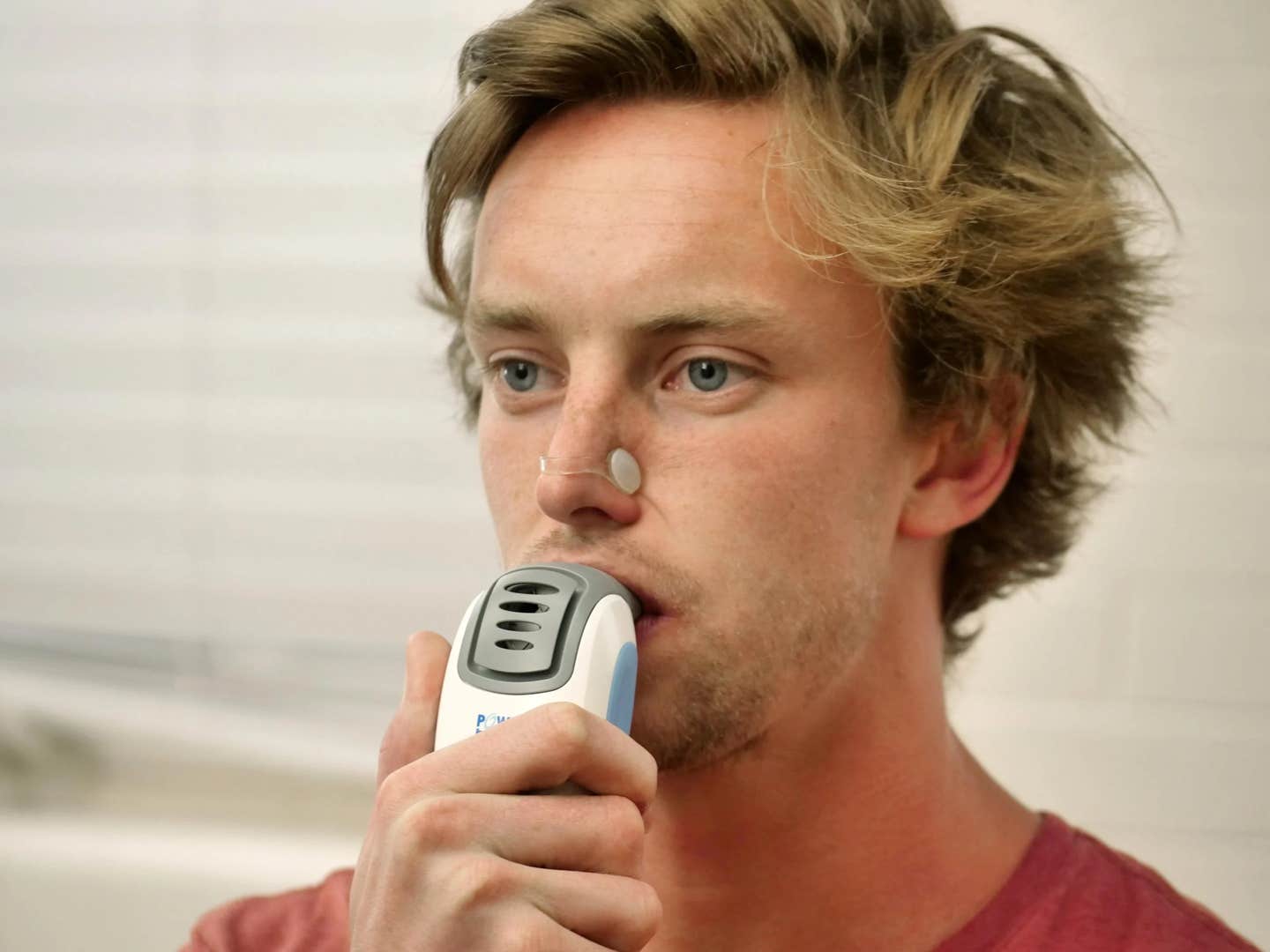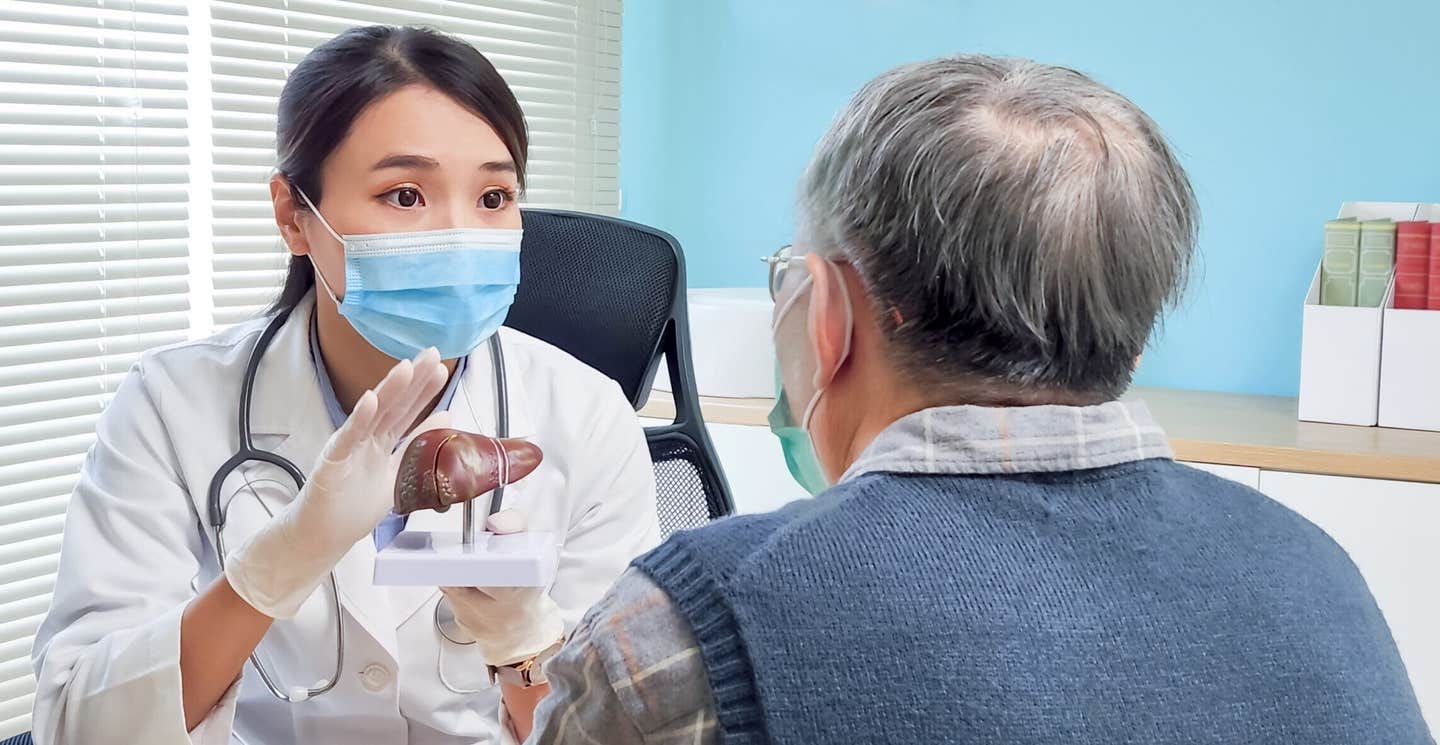5-minute daily breathing workout lowers blood pressure and boosts heart health
A five-minute daily breathing workout lowers blood pressure and boosts artery health as well as medication or exercise.

Tom Heinbockel, a master’s student in integrative physiology at the University of Colorado Boulder, shows how to use a Power Breathe device during a lab session. (CREDIT: Casey A. Cass/University of Colorado)
High blood pressure creeps up as you age. It affects over 65% of adults older than 50 in the U.S. and is one of the biggest risk factors for heart attacks and strokes. The usual advice is to walk more, eat better, and maybe take medication. But for many people, exercise is hard to keep up with, and pills often come with side effects.
What if you could strengthen your heart health by doing something as simple as breathing deeply through a tube for five minutes a day?
That’s the surprising promise of a new technique called High-Resistance Inspiratory Muscle Strength Training, or IMST. It’s essentially strength training for the muscles you use to breathe. The best part? You can do it while sitting on your couch.
A simpler way to boost cardiovascular health
Researchers at the University of Colorado Boulder recently found that just 30 resisted breaths a day for six weeks lowered systolic blood pressure by an average of 9 mmHg. That’s the top number in your blood pressure reading. A drop of that size cuts stroke risk by 35% and heart disease risk by 25%. That’s on par with — or better than — what many people get from drugs or daily jogging.
The study, published in the Journal of the American Heart Association, followed 36 adults aged 50 to 79. Everyone had systolic blood pressure of at least 120 mmHg, putting them in the above-normal range. Half used PowerBreathe, a real IMST device with strong resistance, while the others used a fake version with much less effort required.
After six weeks, the real IMST group saw their blood pressure drop sharply, and many of the benefits stuck around even six weeks after they stopped. Participants also had better blood vessel function and lower levels of inflammation and oxidative stress — two key signs of healthy aging.
Related Stories
- These everyday foods can naturally and significantly lower blood pressure
- Lowering blood pressure helps prevent dementia, major study finds
- Eating more bananas could help lower your blood pressure
Lead author Daniel Craighead, an integrative physiologist at CU Boulder, called it a powerful new tool. “IMST can be done in five minutes in your own home while you watch TV,” he said.
How breathing gets your blood vessels to relax
So how does breath training bring down blood pressure? It turns out your blood vessels have a lining called the endothelium that plays a big role in keeping them relaxed and open. This lining releases nitric oxide, a molecule that widens blood vessels and keeps plaque from building up. But as you get older, nitric oxide levels go down, and your arteries stiffen.
IMST appears to turn that around. The CU Boulder team found that participants had a 45% improvement in how well their arteries expanded after six weeks. Their blood carried more nitric oxide and fewer signs of inflammation. Blood samples even helped cultured human cells make more nitric oxide and fewer damaging reactive oxygen species.
“The muscles we use to breathe atrophy, just like the rest of our muscles tend to do as we get older,” Craighead explained. Strengthening them seems to ripple out into better heart and blood vessel function.
A five-minute daily habit with long-term payoff
Unlike the 30 minutes of moderate aerobic activity five days a week recommended by experts, IMST takes only about five minutes a day. Better yet, adherence is high. Participants in the study completed 95% of their sessions.
That’s a big deal, because fewer than 40% of older adults stick with traditional aerobic exercise plans. There are just too many obstacles — lack of time, money, transportation, or mobility. IMST uses a small, hand-held device that costs far less than a gym membership and fits easily into daily life.
“It’s easy to do, it doesn’t take long, and we think it has a lot of potential to help a lot of people,” Craighead said.
Theresa D. Hernandez, 61, from Boulder, joined the study because of a family history of high blood pressure. She was nearing the threshold where doctors start prescribing medication. After six weeks of breathing training, her blood pressure dropped enough that she no longer needed medication.
“It was a surprise that something so simple could be so profound,” she said. She now does her daily session every morning.
Useful for women, athletes, and young adults too
The study also found that IMST benefits women just as much as men. That’s important because past research has shown that postmenopausal women often don’t get the same vascular benefits from aerobic exercise as men. In this case, both sexes saw similar improvements.
Craighead’s lab is also exploring whether IMST boosts cognitive function and physical performance. Early signs look promising. The method has been tested in endurance athletes, with some seeing a 12% increase in aerobic exercise tolerance after six weeks.
“If you build up endurance of those respiratory muscles, your legs won’t get as fatigued,” said Craighead, who uses IMST in his own marathon training.
What’s more, the results held true across all ages, including healthy younger adults. That suggests IMST might not just be a therapy, but a preventive tool.
“We were surprised to see how ubiquitously effective IMST is,” said Craighead.
A promising future in heart health
While IMST won’t replace medication for those at highest risk or serve as a substitute for aerobic exercise, it’s a compelling addition to healthy routines. It’s also likely safer than many other interventions.
Doug Seals, senior author and Distinguished Professor of Integrative Physiology at CU Boulder, said this new tool could help many who are underserved by current options.
“We have identified a novel form of therapy that lowers blood pressure without giving people pharmacological compounds and with much higher adherence than aerobic exercise,” he said.
The National Institutes of Health is now funding a $4 million follow-up study to compare IMST head-to-head with aerobic training in a larger group. Researchers are also developing a smartphone app so people can use existing commercial devices at home more easily.
Michael Joyner, a physician at the Mayo Clinic who studies blood pressure regulation, says the results are strong enough to suggest adding IMST to preventive care.
“Taking a deep, resisted breath offers a new and unconventional way to generate the benefits of exercise and physical activity,” he said.
So, while your biceps and legs might get all the attention during strength workouts, it turns out the muscles you breathe with matter just as much — especially when it comes to keeping your heart healthy as you age.
Note: The article above provided above by The Brighter Side of News.
Like these kind of feel good stories? Get The Brighter Side of News' newsletter.



